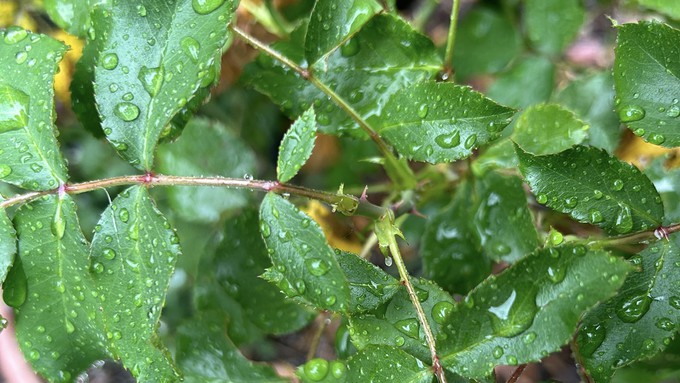
Chilly storm throws another curve into spring weather

This rain-drenched rose shows an example of a blind shoot -- no bud happening here. To remedy, prune the shoot to just above a healthy leaf with five leaflets. Kathy Morrison
“Unsettled”; that’s how the National Weather Service describes our weekend forecast. Saturday (May 4) certainly fit that description with a mix of showers and thunderstorms, gusty winds and much cooler temperatures.
After basking in warm spring sunshine most of this week, Sacramento saw temperatures plunge more than 30 degrees. After 84 degrees on Friday, Saturday stayed chilly and wet in the low 50s.
With “definite rain showers” forecast throughout the day, Sacramento is expected to total ¾ to 1 inch of rain from this storm, says the weather service.
Sunday and Monday are expected to be cool (70ish) but dry. By Wednesday, we’ll be back in the low to mid 80s – with more heat on the horizon. And next weekend? We could see our first 90-degree day of 2024.
More on weather forecast: https://www.weather.gov/sto/.
What does this mean for our gardens? Expect to see more effects of weather whiplash.
Huge fluctuations in temperature and weather conditions confuse plants (as well as gardeners). For example, roses produce “blind shoots,” stems that never produce a bud or bloom. Prune those off, cutting just above a healthy leaf with five leaflets.
* Survey your garden after the storm. Heavy rain and gusty winds can break the neck of large flowers such as roses.
* Keep an eye on new transplants or seedlings; they could take a pounding on Saturday.
* Watch out for powdery mildew. Warmth that follows moist conditions can cause this fungal disease to “bloom,” too. If you see a leaf that looks like it’s dusted with powdered sugar, snip it off.
* After the storm, start setting out tomato transplants, but wait on the peppers and eggplants (they want warmer nights). Pinch off any flowers on new transplants to make them concentrate on establishing roots instead of setting premature fruit.
* Trim dead flowers but not leaves from spring-flowering bulbs such as daffodils and tulips. Those leaves gather energy to create next year's flowers. Also, give the bulbs a fertilizer boost after bloom.
* Pinch chrysanthemums back to 12 inches for fall flowers. Cut old stems to the ground.
* Mulch around plants to conserve moisture and control weeds.
* From seed, plant beans, beets, cantaloupes, carrots, corn, cucumbers, melons, pumpkins, radishes and squash.
* Plant onion sets.
* In the flower garden, plant seeds for asters, cosmos, celosia, marigolds, salvia, sunflowers and zinnias. Transplant petunias, zinnias, geraniums and other summer bloomers.
* Plant perennials and dahlia tubers for summer bloom.
* Don’t wait; plant summer bulbs, such as gladiolus and tuberous begonias.
* Harvest cabbage, lettuce, peas and green onions.
Comments
0 comments have been posted.Sacramento Digs Gardening to your inbox.
Food in My Back Yard Series
April 1: Don't be fooled by these garden myths
March 25: Fertilizer tips: How to 'feed' your vegetables for healthy growth
March 18: Time to give vegetable seedlings some more space
March 11: Ways to win the fight against weeds
March 4: Potatoes from the garden
Feb. 25: Plant a fruit tree now -- for later
Feb. 18: How to squeeze more food into less space
Feb. 11: When to plant? Consider staggering your transplants
Feb. 4: Starting in seed starting
Sites We Like
Garden Checklist for week of March 30
Your garden doesn’t mind April showers. Get busy now to enjoy those future flowers.
* Get ready to swing into action in the vegetable garden. As nights warm up over 50 degrees, start setting out tomato, pepper and eggplant transplants.
* From seed, plant beans, beets, cantaloupes, carrots, corn, cucumbers, melons, pumpkins, radishes and squash. (Soak beet seeds overnight in water for better germination,)
* Plant onion sets.
* In the flower garden, plant seeds for asters, cosmos, celosia, marigolds, salvia, sunflowers and zinnias.
* Transplant petunias, zinnias, geraniums and other summer bloomers.
* Plant perennials and dahlia tubers for summer bloom.
* Transplant lettuce and cabbage seedlings.
* April is the last chance to plant citrus trees such as dwarf orange, lemon and kumquat. These trees also look good in landscaping and provide fresh fruit in winter.
* Smell orange blossoms? Feed citrus trees with a low dose of balanced fertilizer (such as 10-10-10) during bloom to help set fruit. Keep an eye out for ants.
* Apply slow-release fertilizer to the lawn.